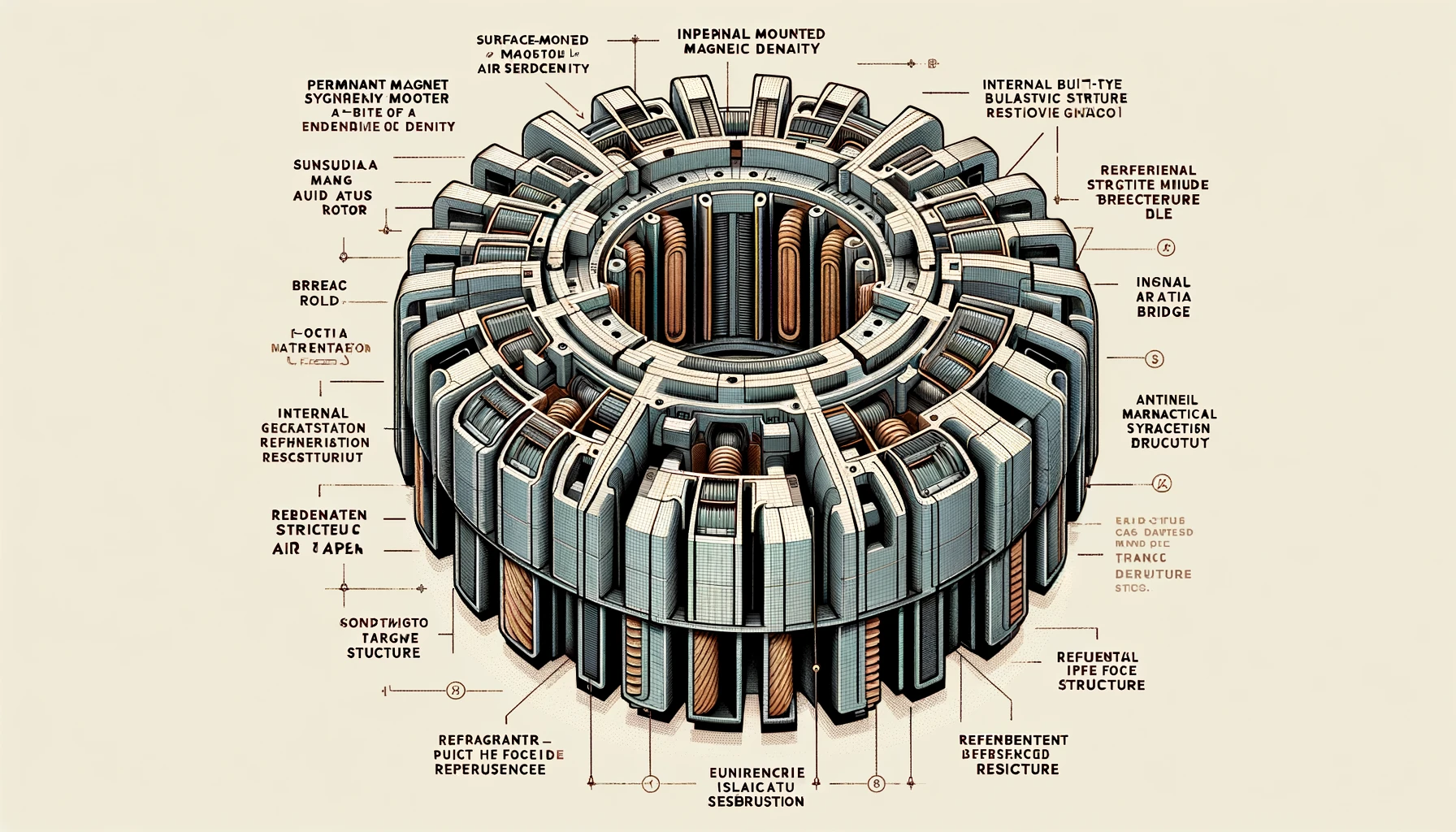The design of the rotors structure in permanent magnet motors is crucial. Different types of rotor structures have their own suitable applications, so it is necessary to study and understand each rotor structure.
#### Considerations for Permanent Magnet Synchronous Motor Rotor Structure Design:
1. **Rotor Waveform Sinusoidalization**
2. **Increase the Difference Between Ld and Lq**
3. **Weaken Certain Harmonics**
4. **Pulsation Suppression**
5. **Ensure Rotor Centrifugal Force**
6. **Meet Weak Magnetic Speed Regulation Capability**
7. **Meet Motor Cost Design Requirements**
8. **Meet Motor Power Factor Requirements**
9. **Ensure Motor Output Power**
#### I. Air Gap Magnetic Density Sinusoidality
**Surface-Mounted Bread-Type Magnet Structure:**
- **Characteristics:** Enhances the sinusoidality of the air gap magnetic density between the stator and rotor, resulting in low torque pulsation and good linearity of torque with current changes. Typically used in small or very large motors, low-speed, and high control requirement environments.
- **Drawbacks:** High eddy currents in magnets, high processing costs of bread-type magnets, not suitable for weak magnetic speed expansion.
**Built-in Unequal Air Gap Structure:**
- **Characteristics:** Improves rotor air gap sinusoidality, reduces torque pulsation, avoids using magnet protection covers, and is suitable for motors with not too high speeds, reducing magnet eddy currents.
- **Drawbacks:** Limited weak magnetic speed expansion capability, certain magnetic leakage compared to surface-mounted motors, larger inductance than surface-mounted motors, and lower power factor. Increased harmonic generation by the stator current.
#### II. Increasing the Difference Between Ld and Lq to Enhance Motor Reluctance Torque
Generally applicable to applications requiring high weak magnetic speed expansion and motors with relatively high torque density.
**Type I:**
- **Characteristics:** Suitable for permanent magnet synchronous motors with an outer diameter of punch sheets within 150 mm requiring certain weak magnetic speed expansion. It saves on magnet material, allows for weak magnetic speed regulation, and can reach speeds up to 8000 rpm.
- **Drawbacks:** Poor speed regulation expansion capability, general reluctance torque component, not suitable for high-speed situations, and poor centrifugal force resistance.
**V-type:**
- **Characteristics:** Simple structure, good weak magnetic speed regulation capability, few rotor design parameters, and can accommodate up to 12000 rpm.
- **Drawbacks:** To suppress power drop phenomena, thicker magnets are used, leading to higher magnet usage. Post weak magnetic high-speed air gap magnetic density waveform and back EMF waveform are poor, reducing high-speed control performance.
**Dual-segment Arc Coefficient:**
- **Characteristics:** Better adjusts rotor magnetic density waveform. Each magnet layer's thickness is generally within 4 mm, minimally damaging q-axis inductance, providing greater reluctance torque. Layered rotor magnets have both magnetic flux and reluctance characteristics, allowing both to be utilized effectively in motor design. Suitable for high-speed high-power, low-speed high-torque applications, not suitable for punch sheets with an outer diameter within 160 mm.
- **Drawbacks:** Complicated magnet insertion, complex rotor structure, increased design variability, and increased rotor variables.
**Double Type I:**
- **Characteristics:** Saves on magnet material, large motor reluctance torque, high high-speed efficiency, low motor cost. Significant cost advantages in high stator electric density schemes, suitable for high-speed running.
- **Drawbacks:** Noticeable power drop phenomena, lower power factor.
#### III. Auxiliary Design for Pulsation Suppression and Harmonic Weakening
1. **Auxiliary Slots on Rotor Air Gap Surface:**
- **Characteristics:** Most auxiliary slots are near the magnetic isolation bridge, creating an uneven air gap effect for the rotor and preventing excessive magnetic density within the magnetic isolation bridge due to magnetic resistance. It has benefits for pulsation suppression and harmonic suppression and can help cool the rotor surface to some extent.
- **Drawbacks:** Not suitable for high-speed situations.
2. **Slots on Rotor Near Air Gap:**
- **Characteristics:** Suppresses stator harmonics, reduces rotor surface iron loss, and helps suppress motor torque pulsation. Small slots increase mold requirements.
#### IV. Ensuring Rotor Centrifugal Force with Magnetic Isolation Bridge and Reinforcement Rib Design
1. **Spring-Type:**
- **Characteristics:** Increases the angles of the two main chamfers bearing centrifugal force through a curved structure design. The spring structure has good spatial adjustment capability.
2. **Auxiliary Opening to Change Magnetic Isolation Bridge Stress Type:**
- **Characteristics:** Improves the magnetic isolation bridge's ability to withstand centrifugal force and enhances spatial expansion capability.
3. **Harmonic Optimization Type:**
- **Characteristics:** Balances structural strength and air gap magnetic density waveform optimization capability.






















